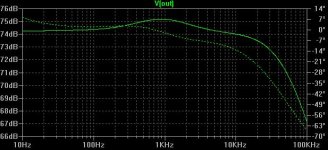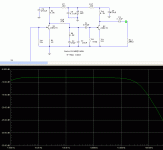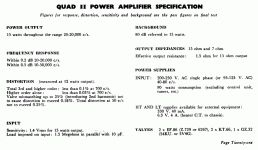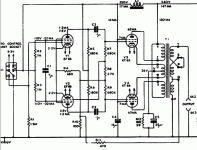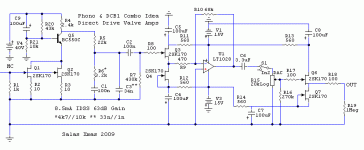I used the values you gave me for the RIAA and as you can see, it is within 1dB but not very flat. You may want to tweak those values.
Ideally, I'd say you need to hit the 500mV mark at 1k with respect to gain. I'm using the peak values to calculate gain (salas, correct me if I'm wrong). Guess you preamp/amp will have to do more work.
RMS is supposed when we talk AC, if not else stated. So you talk 353mV. Those Riaa values could work flatter if Ro 1st stage was included. In your example is the 4k drain load. And the ratio for driving is low, so it upsets the curve further.
Now try R4,R5,C2,C3= 47k 6.8k 47n 16n on 470k load instead of 100k R6 and run the curve again
Studeb,
Have you ordered the JFETs? If yes, what grade are they?
Yes i have, about oh, 13 years ago when the Pacific first came to light. We did not know about the grade peculiarities required. I measured mine, they are 12.1 to 12.4.
If these are not usable, maybe i just skip to the Salas NJFET RIAA.
Thanks for running the RIAA, i am surprised about the bump, those were meant to be tweaked values, i thought by sim, but maybe they were tweaked by ear.
Just do the MC version from that PDF but with 42V B+ so to work with your IDSS. What are your amp and speakers BTW?
The original i schematic i had ran on 36V for the MC pre pre. That was replaced by SUT and a 24V version
Amps are QuadII and speakers are 89 -91db sens. Depends on mood.
After this i think an F5 is next.
I know that 60db gain is about what is needed, so your estimate is very spot on.
I used the line stage (20db gain) in the preamp with a 0.2mV cart previously
Last edited:
Quad II is rather insensitive as tube amps go, probably because its two stage. I would not push such a phono to do all the drive, since its second stage peaks THD the more it swings. Driving the Quad II with a B1 does not help either. Was there a mod that Quad tweakers were doing around EF86s cathode resistors, so to make it more sensitive?
Attachments
Quad II is rather insensitive as tube amps go, probably because its two stage. I would not push such a phono to do all the drive, since its second stage peaks THD the more it swings. Driving the Quad II with a B1 does not help either. Was there a mod that Quad tweakers were doing around EF86s cathode resistors, so to make it more sensitive?
Yes there is that mod, i will try that. 470R instead of 100R.
A long time ago i asked around, and the overwhelmign consensus was replace out of spec parts, and don't change anything, but i did not hear of that mod.
I have replace little on the amps over th years, just the cathode cap and resistor on the output tubes.
Odd. Maybe they use 47R?
you may be onto something, i read 470hm, but 47R would make more sense.
BTW the B1 has no problem driving the amps with a DAC as a source.
Maybe a typo. Anyway, if you can get the Quad II down to 0.7V RMS sensitivity with that mod, I simulated a phono + DCB1 combo idea that could drive most of valve amps directly when fed from a 0.5mV MC cart, with low THD second gain stage, and passive RIAA filter.
Attachments
Any OpAmp could just work. There is both sides buffering and capacitive coupling for Vo offset in the CCT. It just depends on the noise density you can afford in a system, given the speaker's sensitivity, main amp's gain, your priorities etc. Although some parts can be very nice to your ears, here we need an inverting 43dB 2nd gain stage, and the 470 Ohm R9 is the interstage buffering 10xB1Ro limit for driving. Which isn't optimal for noise, but necessary in this case. With circa 1nVrtHz En OpAmps like LT1028A there is roughly a 2.9nVrtHz En reflection from the output contribution for chosen gain and resistors, calculating with datasheet En&In 1kHz, R9=2.74nV, R10 33nV, G=145. Now your proposition has 2.7nVrtHz natively, and goes 3.93nVrtHz in this configuration @ 1kHz. Check in your system for hiss VS tone and choose.
Hi electronic Hi-Fi experts,
I have built some boards for Mads K's Atlantic RIAA, and am finally getting around to building a regulated power supply. I have found some kits for regs on eBay, from a trusted seller Jims_Audio_Store in Hong Kong who does reasonable low priced kits that I've used before.
I need 2x27v DC for two mono-blocked RIAA circuits.
I need something quite cheap, but not lousy quality either and I saw this:
I know it may have some superficial noise level above an ultra-simple reg using K-170 fets, but do you think this will be reasonably satisfactory for a year until I have more money to upgrade?
Also, how many mA is this circuit likely to draw? I'd like as small a transformer as I can get away with but don't know what that's likely to be.
Many thanks for all your help
Lucas
I have built some boards for Mads K's Atlantic RIAA, and am finally getting around to building a regulated power supply. I have found some kits for regs on eBay, from a trusted seller Jims_Audio_Store in Hong Kong who does reasonable low priced kits that I've used before.
I need 2x27v DC for two mono-blocked RIAA circuits.
I need something quite cheap, but not lousy quality either and I saw this:
An externally hosted image should be here but it was not working when we last tested it.
I know it may have some superficial noise level above an ultra-simple reg using K-170 fets, but do you think this will be reasonably satisfactory for a year until I have more money to upgrade?
Also, how many mA is this circuit likely to draw? I'd like as small a transformer as I can get away with but don't know what that's likely to be.
Many thanks for all your help
Lucas
Finally I'm into this pacific phono as well. BIG TIME!
Hi
So, it took me 2 years for my circles to take there places
I was first interrested in Salas and wrenchone and their work. I got a hint from Salas about this allaround "pacific style" phono amp (allmost two years ago). In the meantime I have fiddled with a TetraOne kit from Tubecad (John Broskie) which sound incredible... Thats another thread though .. when I'm "There".
To the point....
At last I got big time trigged on the Norwegian guy Mad_K and his enthusiastic approach (this thread) with the simplest of this schematics of them all, without the cascode and also, no talk about high input capacitance for MM and so forth ... This very thread's first post.
I built it last week, in about two hours (veroboard) and .. it sounded really good and lively. I had a PSU with slightly less then 1mV ripple and I had problems with oscillations. If I put my finger on the right channels signal line it dissapeared :-| My finger was numbed that evening .... The sound was incredible!
I reckoned it was that good I have to try some more.
I'm sorry but I have to get this out of my system and bring my experience off to you in a hurry, even before I have any schematics of my approach avalable ftm.
This Phono amp i incredible good !
I stomp my foot to the floor and changes Vinyl LP's fast ... I have to go trough my collection again. Amasing! Theres music and sounds I never have heard before!
Because I'm a electronic technician and measuring metrology guy, I have f.e. also meaured the input capacitance to around 117 pF which, together with a normal cable around 100pF is OK with a MM measuring around 400mH.
So you maybe wont need the cascode approach Salas mentioned here and there in thoose long threads. I use the SK170GR FET.
I have also measured the THD to be exactly -78dB on both channels, This is the second order THD. There is also a small peak third order way down... then it's all clean! Amasing for a NFB circuit.
I have a very good PSU now and also some LC filtering per stage and also starground for every stage as there own. Exaggerated ... and totally silent when there is no music.
As I have put my cheek out I have to draw my version schematic to show you, I know But it will take some more time.
But it will take some more time.
Anyhow... Try to build this one as the first post in this thred and you will have something which will take your time for a while
Hi
So, it took me 2 years for my circles to take there places
I was first interrested in Salas and wrenchone and their work. I got a hint from Salas about this allaround "pacific style" phono amp (allmost two years ago). In the meantime I have fiddled with a TetraOne kit from Tubecad (John Broskie) which sound incredible... Thats another thread though .. when I'm "There".
To the point....
At last I got big time trigged on the Norwegian guy Mad_K and his enthusiastic approach (this thread) with the simplest of this schematics of them all, without the cascode and also, no talk about high input capacitance for MM and so forth ... This very thread's first post.
I built it last week, in about two hours (veroboard) and .. it sounded really good and lively. I had a PSU with slightly less then 1mV ripple and I had problems with oscillations. If I put my finger on the right channels signal line it dissapeared :-| My finger was numbed that evening .... The sound was incredible!
I reckoned it was that good I have to try some more.
I'm sorry but I have to get this out of my system and bring my experience off to you in a hurry, even before I have any schematics of my approach avalable ftm.
This Phono amp i incredible good !
I stomp my foot to the floor and changes Vinyl LP's fast ... I have to go trough my collection again. Amasing! Theres music and sounds I never have heard before!
Because I'm a electronic technician and measuring metrology guy, I have f.e. also meaured the input capacitance to around 117 pF which, together with a normal cable around 100pF is OK with a MM measuring around 400mH.
So you maybe wont need the cascode approach Salas mentioned here and there in thoose long threads. I use the SK170GR FET.
I have also measured the THD to be exactly -78dB on both channels, This is the second order THD. There is also a small peak third order way down... then it's all clean! Amasing for a NFB circuit.
I have a very good PSU now and also some LC filtering per stage and also starground for every stage as there own. Exaggerated ... and totally silent when there is no music.
As I have put my cheek out I have to draw my version schematic to show you, I know
Anyhow... Try to build this one as the first post in this thred and you will have something which will take your time for a while
I have Mad K's Atlantis.
Its a fully bjt cascoded, and bjt cascode followed, 2 stage jfet base cct, with passive Riaa. (Thanks Salas ) It's single Ended, zero feedback. Class A (Pulls 27mA, but the hot-rodded Salas shunt reg I have now bumps that up to 200mA).
) It's single Ended, zero feedback. Class A (Pulls 27mA, but the hot-rodded Salas shunt reg I have now bumps that up to 200mA).
I believe Mads K is using this one from 2007 in his system too. It is very nice indeed.
Its a fully bjt cascoded, and bjt cascode followed, 2 stage jfet base cct, with passive Riaa. (Thanks Salas
I believe Mads K is using this one from 2007 in his system too. It is very nice indeed.
- Home
- Source & Line
- Analogue Source
- Ultrasimple MM/MC RIAA preamp 2
